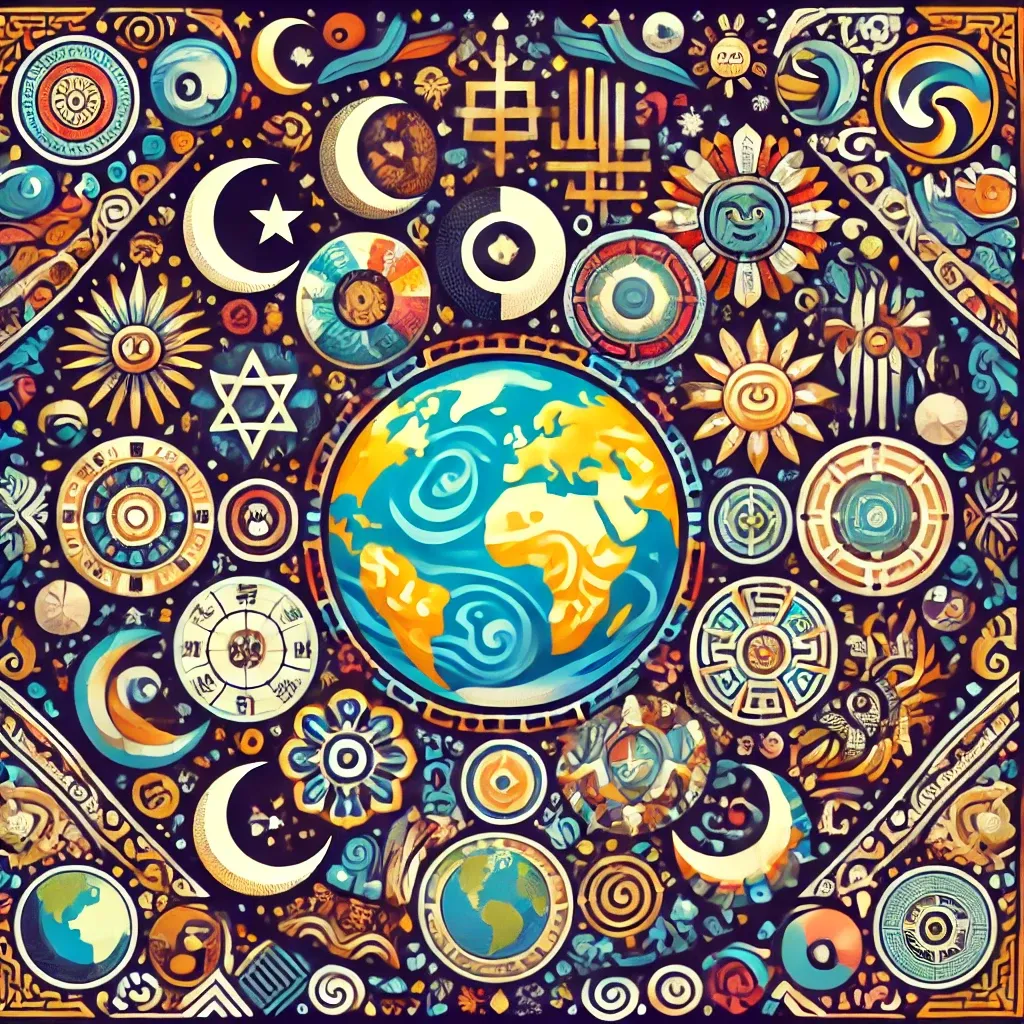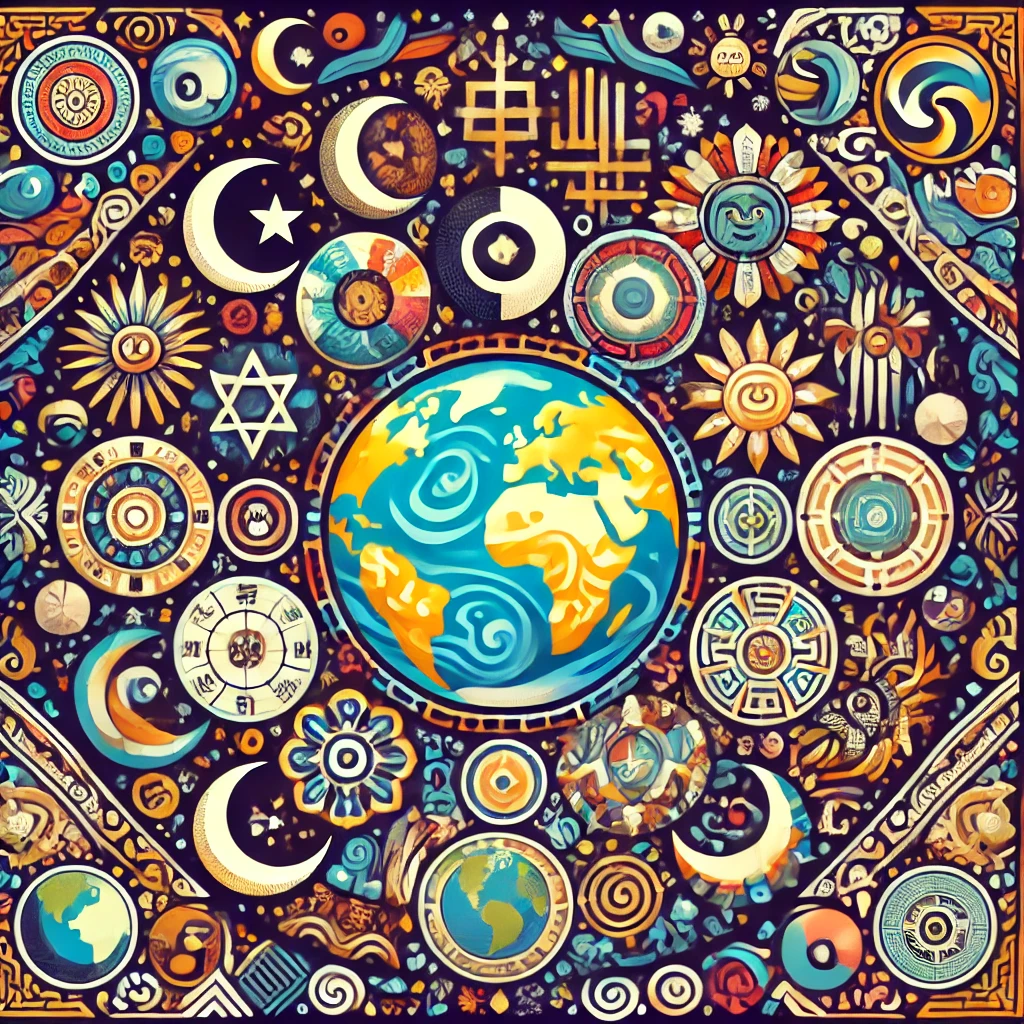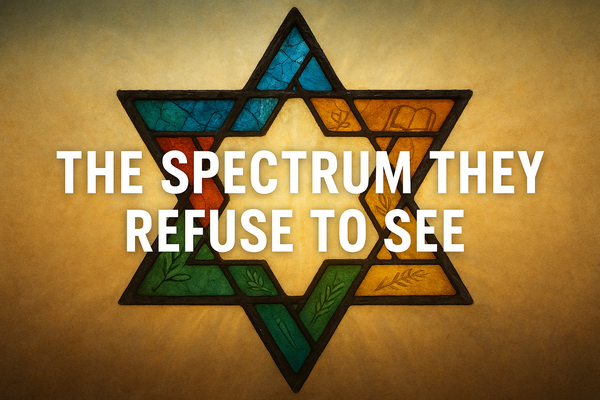From Lunar Months to Solar Years: The Diversity of Traditional Calendars

Traditional Calendars and Their Unique Approaches
Calendars are humanity’s oldest tools for measuring time, essential for aligning our lives with the rhythms of nature. Whether planning harvests, navigating seasons, or orchestrating cultural rituals, calendars reflect a society’s intimate relationship with its environment. Each calendar system, shaped by the challenges of its time and place, offers a unique solution to a shared puzzle: how to reconcile the cycles of the sun, moon, and Earth with the human need for order and predictability.
The design of any calendar faces several universal challenges. The agricultural cycle requires synchronization with seasonal changes, dictated by the solar year of 365.251 days. Meanwhile, the moon’s 29.53-day cycle creates months that drift out of sync with the solar year. Attempts to harmonize these two systems often rely on the Metonic cycle, a 19-year period that aligns 235 lunar months with 19 solar years. However, different cultures have approached these challenges in ways that reveal their values, priorities, and connections to the natural world.
In this blog post, we’ll explore how various traditional calendars—from the Jewish and Islamic systems to the Chinese, Maori, Mesoamerican, and beyond—address these challenges. By comparing their approaches to agricultural and seasonal cycles, lunar rhythms, and solar synchronization, we uncover the creativity and cultural depth embedded in the art of timekeeping.
Core Cycles and Calendar Design Challenges
The design of calendars is rooted in reconciling various natural cycles that govern life on Earth. Here are the primary cycles and the challenges they pose:
Agricultural and Seasonal Cycles Agricultural societies depend on precise knowledge of seasonal changes to determine the timing of planting, harvesting, and other critical activities. These cycles are tied to the solar year, which is approximately 365.251 days long. Aligning a calendar with these changes ensures survival and prosperity but requires regular adjustments to account for the fractional day.
Lunar Cycles The moon’s phases—waxing, waning, full, and new—follow a 29.53-day cycle. Many early calendars used this lunar rhythm to mark months. However, twelve lunar months add up to only 354.36 days, leaving a gap of about 11 days compared to the solar year. This misalignment creates drift over time, with lunar months falling out of sync with the seasons.
Solar Year The solar year defines the time it takes for Earth to complete one orbit around the sun. This cycle governs seasonal changes but does not divide evenly into whole days, months, or years, leading to the need for intercalation—the addition of extra days or months—to maintain alignment with astronomical events.
Metonic Cycle One of the most ingenious solutions to the lunar-solar alignment problem is the Metonic cycle. Over 19 years, 235 lunar months align closely with 19 solar years. Many lunisolar calendars use this cycle to periodically add an extra month, keeping lunar months roughly in step with the solar year.
Cultural and Regional Variations Every calendar reflects the unique priorities and environmental contexts of the society that created it. Whether guided by agricultural needs, religious practices, or astronomical observations, traditional calendars encode a community’s relationship with time and nature.
By understanding these cycles and their challenges, we can better appreciate the ingenuity behind humanity’s diverse calendar systems.
3.A. Jewish Calendar (Hebrew Calendar)
The Jewish calendar, also known as the Hebrew calendar, is a lunisolar system that harmonizes the lunar months with the solar year through the Metonic cycle. It consists of 12 lunar months in a regular year and 13 months in a leap year, with an extra month, Adar II, inserted seven times over 19 years. This intercalation ensures that the Jewish holidays remain aligned with their intended seasons, particularly agricultural festivals like Passover in spring and Sukkot in autumn.
Each month begins with the new moon, making the calendar deeply attuned to lunar rhythms. Months are either 29 or 30 days long, closely reflecting the 29.53-day lunar cycle. To account for discrepancies between lunar and solar cycles, adjustments are made to the calendar based on astronomical calculations and ancient traditions.
The Jewish calendar’s structure supports both religious observance and agricultural planning. For example, the timing of Passover aligns with the barley harvest in Israel, while the festival of Sukkot corresponds with the fruit harvest. By bridging the lunar and solar cycles, the Hebrew calendar reflects a profound connection between spiritual practices and the natural world.
3.B. Islamic Calendar
The Islamic calendar, also known as the Hijri calendar, is a purely lunar system with 12 months. Unlike lunisolar calendars, it does not include intercalation to align with the solar year. As a result, the Islamic calendar cycles through all seasons over a 33-year period, with the lunar year being approximately 11 days shorter than the solar year.
Each month begins with the sighting of the crescent moon, making the calendar deeply connected to astronomical observations. The months are either 29 or 30 days long, reflecting the lunar cycle’s 29.53-day period. Key Islamic observances, such as Ramadan, Eid al-Fitr, and Eid al-Adha, are determined by this calendar, shifting across different seasons over decades.
This lack of alignment with the solar year reflects the Islamic calendar’s spiritual focus, prioritizing religious rituals and lunar rhythms over agricultural cycles. It emphasizes the universality of Islamic practices, unbound by specific seasonal contexts. The calendar’s reliance on moon sighting also underscores a connection to natural phenomena, maintaining a direct link to the heavens and the divine.
3.C. Babylonian Calendar
The Babylonian calendar, one of the earliest recorded lunisolar systems, was foundational to many subsequent calendar traditions, including the Jewish and Greek systems. It consisted of 12 lunar months, each beginning with the first visible crescent moon, and was periodically adjusted by adding an intercalary month to align with the solar year. This intercalation was determined through careful observation of astronomical events, particularly the spring equinox.
The months were named after key agricultural or religious activities, highlighting the calendar’s dual role in regulating both civic and sacred life. For example, certain months marked significant festivals dedicated to Babylonian deities, aligning communal activities with celestial and seasonal cycles.
The Babylonian calendar’s structure reflects the civilization’s advanced understanding of astronomy. Their adoption of a 19-year cycle to harmonize lunar and solar years influenced later calendars. This emphasis on precision and observation set a standard for timekeeping that resonated through subsequent cultures, underscoring the centrality of celestial patterns in human organization.
3.D. Chinese Calendar
The Chinese calendar is a sophisticated lunisolar system that integrates lunar months with solar terms to harmonize with both the moon’s phases and seasonal changes. It consists of 12 lunar months in a regular year and occasionally adds an intercalary month, resulting in a 13-month year to keep the calendar in sync with the solar year. This adjustment is based on astronomical calculations and ensures that festivals and agricultural activities align with the appropriate seasons.
One of the calendar’s unique features is the division of the solar year into 24 solar terms, or jieqi, each corresponding to a specific phase of the Earth’s orbit around the sun. These solar terms play a critical role in guiding agricultural activities, such as planting and harvesting, and are closely tied to traditional Chinese culture and festivals.
The Chinese New Year, also known as the Spring Festival, is determined by the second new moon after the winter solstice, illustrating the calendar’s blend of lunar and solar elements. Other significant festivals, such as the Mid-Autumn Festival, are tied to lunar phases and seasonal transitions, reflecting the calendar’s role in bridging human activities with celestial rhythms.
By combining lunar months, solar terms, and intercalary adjustments, the Chinese calendar demonstrates a deep understanding of astronomy and its practical application to daily life. This balance of lunar and solar cycles has enabled it to remain a vital cultural and agricultural tool for thousands of years.
3.E. Maori Calendar (Maramataka)
The Maori calendar, known as the Maramataka, is a lunar-based system that aligns with the environmental rhythms of Aotearoa (New Zealand). The Maramataka divides the year into lunar months, with each month beginning and ending with the new moon. Unlike many other systems, it places significant emphasis on the connection between lunar phases, natural phenomena, and daily activities.
The calendar designates specific lunar phases as favorable or unfavorable for various activities, such as fishing, planting, and harvesting. For example, certain days within the waxing moon are ideal for planting crops, while other phases might be better suited for fishing based on tidal patterns.
The Maramataka is also deeply rooted in Maori cosmology, linking celestial movements to the spiritual and physical realms. Seasonal markers, such as the heliacal rising of the star cluster Matariki (Pleiades), signify the Maori New Year and serve as a time for reflection, celebration, and planning for the year ahead.
By integrating lunar cycles with environmental cues and cultural traditions, the Maramataka reflects the Maori people’s profound relationship with their land, sea, and sky. It stands as a testament to the adaptability and ecological awareness of indigenous timekeeping systems.
3.F. Aboriginal Australian Calendars
Aboriginal Australian calendars are deeply rooted in the natural environment, reflecting a profound connection to seasonal and ecological cycles. Rather than relying on a fixed system of months or years, these calendars are often based on observable environmental phenomena such as the flowering of plants, the migration of animals, or changes in weather patterns.
Many Aboriginal groups divide the year into distinct seasons, which vary depending on the region. For example, the Yolngu people of northern Australia recognize six seasons, each tied to specific environmental events such as monsoon rains or dry periods. These seasons guide activities like hunting, gathering, and ceremonial practices.
Astronomy also plays a role, with the positions of stars and constellations serving as seasonal markers. The heliacal rising of certain stars, for instance, might signal the start of a particular season or the availability of specific food resources. This integration of celestial and terrestrial observations reflects a holistic approach to timekeeping.
Aboriginal calendars are not just practical tools but are also woven into the cultural and spiritual fabric of their societies. They are passed down through oral traditions, songlines, and Dreaming stories, ensuring that knowledge of time, place, and ecology is preserved across generations. These systems highlight the adaptability and ecological sensitivity of Indigenous knowledge, offering valuable insights into sustainable living.
3.G. African Calendars
African calendars are as diverse as the continent itself, with different regions and cultures developing systems that align with local environmental, agricultural, and astronomical conditions. Two prominent examples are the Ethiopian calendar and the Akan calendar, each reflecting unique approaches to timekeeping.
The Ethiopian calendar is a solar-based system with 13 months—12 months of 30 days each and a short 13th month, Pagumē, consisting of five or six days depending on whether it is a leap year. This structure closely aligns with the solar year and serves both religious and agricultural purposes. It remains in use today, particularly within the Ethiopian Orthodox Church.
The Akan calendar, used by the Akan people of West Africa, operates on a 40-day cycle called the “Adae” cycle, which is central to their cultural and spiritual life. This system is tied to sacred rituals and the veneration of ancestors, with specific days designated for communal activities, ceremonies, and rest. The Akan calendar also reflects the agricultural rhythms of the region, ensuring that activities such as planting and harvesting are in harmony with the natural environment.
African calendars often incorporate celestial observations, such as the rising of the star Sirius, which was historically used by the ancient Egyptians to predict the annual flooding of the Nile. These systems highlight the deep interconnection between celestial patterns, agricultural practices, and spiritual beliefs in African cultures, emphasizing their holistic approach to timekeeping.
3.H. Mesoamerican Calendars
Mesoamerican calendars, such as those developed by the Maya and Aztec civilizations, are among the most complex and sophisticated systems of timekeeping in history. These calendars combine astronomical precision with spiritual and agricultural significance, reflecting a deep integration of celestial and terrestrial cycles.
The Maya utilized two primary calendars: the Tzolk'in, a 260-day ritual calendar, and the Haab', a 365-day solar calendar. These two systems interlocked to create a larger cycle of 52 Haab' years, known as the Calendar Round. The Tzolk'in guided religious ceremonies and divination, while the Haab' was used to track agricultural activities and seasonal changes.
The Aztecs adopted a similar dual-calendar system, incorporating their own ritual and solar calendars. The Tonalpohualli, a 260-day calendar, was used for religious purposes and personal horoscopes, while the Xiuhpohualli, a 365-day calendar, organized civic and agricultural life. Together, these calendars underscored the interconnectedness of spiritual and practical concerns in Mesoamerican cultures.
A third notable feature of Mesoamerican timekeeping is the Long Count calendar, used primarily by the Maya to record historical and mythological events over vast periods of time. The Long Count operates on a base-20 and base-18 system, capable of tracking time across millennia. Its most famous endpoint corresponded to the year 2012 in the Gregorian calendar, sparking widespread interpretations about its significance.
Mesoamerican calendars also aligned with celestial phenomena, such as the cycles of Venus, which were meticulously tracked for both astronomical and ritual purposes. These calendars served not only as practical tools but also as a means of connecting humanity with the cosmos, providing a framework for understanding the universe and humanity’s place within it.
3.I. Hawaiian Calendar (Kaulana Mahina)
The Hawaiian calendar, known as the Kaulana Mahina, is a lunar system deeply tied to the islands’ natural rhythms and cultural practices. It divides the lunar month into three 10-day periods called anahulu: ho‘onui (waxing phase), poepoe (full phase), and emi (waning phase). Each phase is further divided into days that hold specific significance for planting, fishing, and other activities.
The Kaulana Mahina guides the timing of agricultural and ceremonial practices based on the moon’s position and phase. For instance, certain days during the waxing moon are ideal for planting crops, as they are believed to promote growth, while specific days during the waning moon are considered better for harvesting or pruning.
Seasonal markers also play a role, with the rising of particular stars and constellations signaling shifts in weather patterns and ecological events. For example, the heliacal rising of the star cluster Makali‘i (Pleiades) marks the beginning of the Makahiki season, a time of rest, celebration, and tribute to the Hawaiian god Lono.
The Kaulana Mahina reflects a harmonious relationship between the Hawaiian people and their environment. By integrating lunar phases, star positions, and ecological cues, it serves as both a practical tool for survival and a spiritual guide, emphasizing balance and sustainability in daily life.
3.J. Pagan and European Pre-Christian Calendars
Pagan and pre-Christian European calendars often revolved around solar and lunar cycles, deeply intertwined with agricultural and ritual practices. Among the most prominent is the Celtic Wheel of the Year, a solar calendar that divides the year into eight festivals, marking solstices, equinoxes, and cross-quarter days. These include Samhain, Imbolc, Beltane, and Lughnasadh, which correspond to critical points in the agricultural cycle.
The Norse calendar, utilized by early Germanic and Scandinavian peoples, was a lunisolar system that divided the year into two main seasons: winter and summer. Key festivals, such as Yule (the winter solstice) and Midsummer, aligned with seasonal changes and agricultural needs. The Norse calendar also incorporated lunar months, with adjustments to keep the calendar synchronized with the solar year.
In addition to agricultural alignment, these calendars were deeply spiritual, reflecting a belief in the interconnectedness of human life with the cosmos. The phases of the moon guided rituals and the timing of sacred events, while the solstices and equinoxes were seen as moments of profound cosmic balance.
These systems highlight the ingenuity of early European cultures in creating calendars that aligned with both natural cycles and cultural needs, offering insight into their worldview and relationship with nature.
3.K. Traditional Indian Calendar
The traditional Indian calendar, commonly known as the Panchang, is a lunisolar system that aligns lunar months with the solar year. It is widely used across India in various forms, guiding religious observances, agricultural activities, and daily life.
The calendar divides the year into 12 lunar months, each beginning with either a new moon or full moon depending on regional tradition. Since the lunar year of 354 days falls short of the solar year by about 11 days, an intercalary month known as Adhika Masa is added every two to three years to maintain alignment with the solar year.
The Panchang incorporates a sidereal year, tracking the sun's apparent movement against the fixed stars. This sidereal adjustment ensures synchronization with agricultural seasons and solar transitions, such as the equinoxes and solstices.
The calendar also divides the sky into 27 lunar mansions, or nakshatras, which guide the timing of rituals, festivals, and auspicious events. Each month is further divided into 30 lunar days, called tithis, which are categorized into waxing (Shukla Paksha) and waning (Krishna Paksha) phases.
Agricultural festivals like Pongal and Makar Sankranti are intricately tied to this calendar, celebrating harvests and marking the sun’s transition into Capricorn (Makara). These events reflect the calendar’s role in aligning human activity with seasonal and celestial rhythms.
The Panchang’s structure varies regionally. The Vikram Samvat is prevalent in northern India, the Saka Era is used officially by the Indian government, and the Malayalam calendar is unique to Kerala. Despite these variations, the core principles of the Panchang remain consistent, emphasizing harmony between lunar and solar cycles.
The traditional Indian calendar exemplifies a sophisticated understanding of astronomy, ecology, and spirituality. Its ability to integrate these elements into a cohesive timekeeping system underscores its enduring relevance and cultural significance.
4. Comparative Analysis of Traditional Calendars
Traditional calendars reflect diverse approaches to reconciling natural cycles with human needs, shaped by unique cultural and environmental contexts. This section examines the similarities and differences among these systems, highlighting how each addresses agricultural cycles, lunar rhythms, solar synchronization, and cultural significance.
Key Features Comparison
The table below summarizes the main features of the traditional calendars discussed:
Key Similarities
- Integration with Nature: Nearly all traditional calendars are deeply attuned to natural cycles, whether lunar, solar, or ecological.
- Cultural Reflection: Calendars serve as cultural artifacts, encoding societal values, religious practices, and cosmological beliefs.
- Agricultural Alignment: Many calendars are designed to guide planting and harvesting, ensuring survival and prosperity.
Key Differences
- Solar vs. Lunar Focus: While some calendars prioritize the lunar cycle (e.g., Islamic, Maori), others integrate solar synchronization (e.g., Jewish, Chinese).
- Cultural Diversity: The significance of celestial events varies widely—e.g., Venus cycles in Mesoamerican systems versus Pleiades in Maori and Hawaiian systems.
- Practical vs. Ritual Use: Some calendars (e.g., Mesoamerican) emphasize ritualistic and cosmological functions, while others (e.g., Aboriginal) focus on ecological practicality.
Insights and Lessons
Traditional calendars illustrate humanity’s ability to adapt timekeeping to local needs and cosmic rhythms. They offer valuable perspectives for modern sustainability by emphasizing harmony with nature and cyclical thinking.
5. The Relevance of Traditional Calendars in Modern Times
While modern calendars like the Gregorian system dominate global timekeeping, traditional calendars continue to play a vital role in preserving cultural identity, ecological harmony, and spiritual practices.
Cultural Preservation
Traditional calendars serve as a bridge to the past, maintaining rituals, festivals, and practices that define cultural identities. For instance, the use of the Jewish calendar for Passover or the Panchang for Diwali ensures that these festivals retain their historical and spiritual significance. By aligning celebrations with natural cycles, traditional calendars keep cultural traditions deeply rooted in their original contexts.
Ecological Awareness
Many traditional calendars are intimately tied to the environment, offering insights into seasonal changes and natural rhythms. Aboriginal calendars, for example, reflect ecological cycles, while the Maori Maramataka guides fishing and planting based on lunar phases. In an era of climate change and environmental challenges, these systems offer valuable lessons in sustainable living and ecological stewardship.
Spiritual Connection
Traditional calendars foster a connection between humanity and the cosmos, emphasizing the interconnectedness of natural and spiritual realms. The Mesoamerican Long Count calendar’s cosmic focus or the Kaulana Mahina’s alignment with lunar phases reminds modern societies of the importance of observing celestial cycles and their impact on daily life.
Challenges in Modern Integration
Despite their relevance, traditional calendars face challenges in a world dominated by the Gregorian system. Standardized global timekeeping often sidelines these systems, reducing their visibility and usage. However, efforts to revive and adapt these calendars in digital formats and educational initiatives are gaining momentum.
Modern Adaptations and Applications
Some traditional calendars are finding renewed purpose in addressing contemporary needs:
- Cultural Revival: Digital apps and online Panchang platforms make traditional Indian calendars accessible to younger generations.
- Agricultural Planning: Farmers in regions like Africa and Asia still rely on traditional calendars for planting and harvesting guidance.
- Global Recognition: International festivals like Chinese New Year showcase the global appeal of traditional timekeeping.
Conclusion
Traditional calendars are more than tools for measuring time; they are repositories of knowledge, culture, and ecological wisdom. As societies strive for sustainability and cultural preservation, these ancient systems offer valuable frameworks for living in harmony with nature and honoring humanity’s diverse heritage.
Listen to the Podcast






